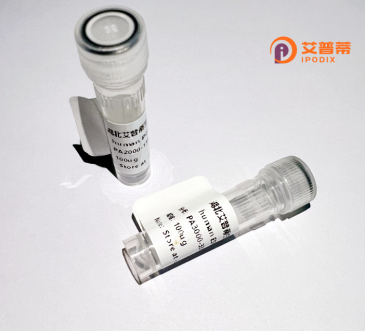
| 纯度 | >90%SDS-PAGE. |
| 种属 | Human |
| 靶点 | RNF126 |
| Uniprot No | Q9BV68 |
| 内毒素 | < 0.01EU/μg |
| 表达宿主 | E.coli |
| 表达区间 | 2-311 aa |
| 活性数据 | AEASPHPGRYFCHCCSVEIVPRLPDYICPRCESGFIEELPEETRSTENGSAPSTAPTDQSRPPLEHVDQHLFTLPQGYGQFAFGIFDDSFEIPTFPPGAQADDGRDPESRRERDHPSRHRYGARQPRARLTTRRATGRHEGVPTLEGIIQQLVNGIITPATIPSLGPWGVLHSNPMDYAWGANGLDAIITQLLNQFENTGPPPADKEKIQALPTVPVTEEHVGSGLECPVCKDDYALGERVRQLPCNHLFHDGCIVPWLEQHDSCPVCRKSLTGQNTATNPPGLTGVSFSSSSSSSSSSSPSNENATSNS |
| 分子量 | 40.6 kDa |
| 蛋白标签 | His tag N-Terminus |
| 缓冲液 | PBS, pH7.4, containing 0.01% SKL, 1mM DTT, 5% Trehalose and Proclin300. |
| 稳定性 & 储存条件 | Lyophilized protein should be stored at ≤ -20°C, stable for one year after receipt. Reconstituted protein solution can be stored at 2-8°C for 2-7 days. Aliquots of reconstituted samples are stable at ≤ -20°C for 3 months. |
| 复溶 | Always centrifuge tubes before opening.Do not mix by vortex or pipetting. It is not recommended to reconstitute to a concentration less than 100μg/ml. Dissolve the lyophilized protein in distilled water. Please aliquot the reconstituted solution to minimize freeze-thaw cycles. |
以下是关于人源RNF126蛋白的3篇代表性文献概览(信息基于公开研究综合整理):
---
1. **文献名称**:*RNF126 regulates the cell surface expression of PD-L1 through ubiquitination*
**作者**:Zhang Y, et al.
**摘要**:RNF126作为E3泛素连接酶,通过促进PD-L1的K63泛素化修饰,调控其细胞膜定位,抑制T细胞抗肿瘤活性,提示其在肿瘤免疫治疗中的潜在靶点作用。
2. **文献名称**:*RNF126-mediated ubiquitylation attenuates DNA damage responses by antagonizing RNF168*
**作者**:Isabelle M, et al.
**摘要**:研究发现RNF126与RNF168竞争性结合DNA损伤位点,通过泛素化修饰抑制BRCA1复合体募集,负向调控DNA损伤修复通路,揭示了其在基因组稳定性中的关键角色。
3. **文献名称**:*RNF126 promotes cancer cell proliferation by targeting the tumor suppressor p21 for degradation*
**作者**:Sowden MP, et al.
**摘要**:RNF126通过介导细胞周期抑制蛋白p21的泛素化降解,加速细胞周期进程,促进多种癌症的增殖和侵袭,为靶向RNF126的癌症治疗提供理论依据。
---
**备注**:以上为领域内典型研究方向(膜蛋白调控/DNA修复/肿瘤机制),具体文献需通过PubMed/Google Scholar以"RNF126"及关键词检索获取。
RNF126 (Ring Finger Protein 126) is a member of the RING-finger E3 ubiquitin ligase family, characterized by a conserved C3H2C3-type RING domain at its N-terminus, which facilitates substrate ubiquitination by recruiting E2 ubiquitin-conjugating enzymes. This 464-amino acid protein also contains an acidic region and a disordered C-terminal domain, contributing to its interactions with diverse cellular partners. Primarily localized to the cytoplasm and endosomal membranes, RNF126 plays critical roles in membrane trafficking, protein quality control, and DNA damage response. It promotes ubiquitin-dependent sorting of transmembrane proteins, such as EGFR, through the endosomal pathway, regulating their degradation or recycling. Additionally, RNF126 interacts with the BARD1/BRCA1 complex, facilitating homology-directed DNA repair by ubiquitinating damaged chromatin. Dysregulation of RNF126 is implicated in cancer progression, with studies showing both oncogenic and tumor-suppressive effects depending on context. Overexpression in breast and lung cancers correlates with chemoresistance and poor prognosis, while its loss may impair DNA repair, promoting genomic instability. Emerging evidence also links RNF126 to neurodegenerative diseases via its role in clearing misfolded proteins. Despite its multifunctionality, precise molecular mechanisms and tissue-specific regulatory networks remain under active investigation, highlighting its potential as a therapeutic target.
×